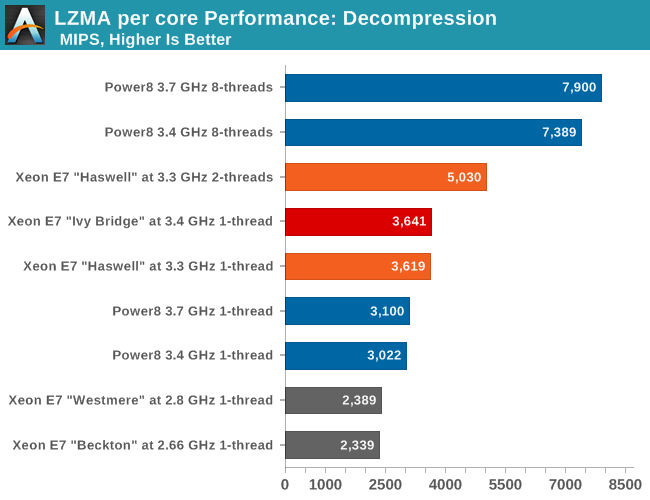The Intel Xeon E7-8800 v3 Review: The POWER8 Killer?
by Johan De Gelas on May 8, 2015 8:00 AM EST- Posted in
- CPUs
- IT Computing
- Intel
- Xeon
- Haswell
- Enterprise
- server
- Enterprise CPUs
- POWER
- POWER8
7-Zip Decompression
Up next, let's see how the chips compare in decompression. Decompression is an even lower IPC workload, as it is very branch intensive and depends on the latencies of the multiply and shift instructions.

The slightly higher clock of "Ivy Bridge EX" is enough to keep up with "Haswell EX".
Meanwhile, once again the Haswell core proves to be a bit more capable. It sustains 20% higher IPC with one thread. But run 8 threads inside the most powerful RISC core ever, and the POWER8 beats the XEON E7 by a massive margin: it is almost 50% (!) faster. Wow. Don't believe it? see below.
Now, in defense of Intel, decompression has an exotic instruction mix. You should optimize for the common case, not for exotic software. So we were told by the RISC vendors 30 years ago...
Want more POWER8 benchmarks? Unfortunately we'll have to dissapoint you. The limited server we tested on was not able to run any of our server workloads as we only had one core and less than 2 GB to work with.











146 Comments
View All Comments
DanNeely - Friday, May 8, 2015 - link
Intel's 94% market share is still only ~184k systems. That's tiny compared to the mainstream x86 market; and doesn't give a lot of (budgetary) room to make radical changes to CPU vs just scaling shared designs to a huger layout.theeldest - Friday, May 8, 2015 - link
184k for 4S systems. The number of 2S systems *greatly* outnumbers the 184k.Samus - Sunday, May 10, 2015 - link
by 100 orders of magnitude, easily.2S systems are everywhere these days, I picked up a Lenovo 2S Xeon system for $600 NEW (driveless, 4GB RAM) from CDW.
4S, on the other hand, is considerably more rare and starts at many thousands, even with 1 CPU included.
erple2 - Sunday, May 10, 2015 - link
Well, maybe 2 orders of magnitude. 100 orders of magnitude would imply, based on the 184k 4S systems, more 2S systems than atoms in the universe. Ok, I made that up, I don't know how many atoms are in the universe, but 10^100 is a really big number. Well, 10^105, if we assume 184k 4S systems.I think you meant 2 orders of magnitude.
mapesdhs - Sunday, May 10, 2015 - link
Yeah, that made me smile too, but we know what he meant. ;)evolucion8 - Monday, May 11, 2015 - link
That would be right if Intel cores are wide enough which aren't compared to IBM. For example, according to this review, enabling two way SMT boosted the performace to 45% and adding two more threads added 30% more performance. On the other hand, enabling two way SMT on the latest i7 architecture can only go up to 30% on the best case scenario.chris471 - Friday, May 8, 2015 - link
Great article, and I'm looking forward to see more Power systems.I would have loved to see additional benchmarks with gcc flags -march=native -Ofast. Should not change stream triad results, but I think 7zip might profit more on Power than on Xeon. Most software is not affected by the implied -ffast-math.
close - Friday, May 8, 2015 - link
It reminds me of the time when Apple gave up on PowerPC in mobiles because the new G5s were absolute power guzzlers and made space heaters jealous. And then gave up completely and switched to Intel because the 2 dual core PowerPC 970MP CPUs at 2.5GHz managed to pull 250W of power and needed liquid cooling to be manageable.IBM is learning nothing from past mistakes. They couldn't adapt to what the market wanted and the more nimble competition was delivering 25-30 years ago when fighting Microsoft, it already lost business to Intel (which is actually only nimble by comparison), and it's still doing business and building hardware like we're back in the '70s mainframe age.
name99 - Friday, May 8, 2015 - link
You are assuming that the markets IBM sells into care about the things you appear to care about (in particular CPU performance per watt). This is a VERY dubious assumption.The HPC users MAY care (but I'd need to see evidence of that). For the business users, the cost of the software running on these systems dwarfs the lifetime cost of their electricity.
SuperVeloce - Saturday, May 9, 2015 - link
They surely care. Why wouldn't they. A whole server rack or many of them in fact do use quite a bit of power. And cooling the server room is very expensive.